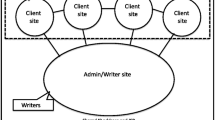Abstract
Document assembly and other substantive legal practice applications are the most knowledge-intense forms of software now widely available in the legal technology marketplace. This article provides an illustrative look at two contemporary practice system engines-CAPS and Scrivener-and examines their relevance for AI-and-law researchers.
Similar content being viewed by others
References
Boyd, W. & Saxon, C. 1981. The A-9: A Program for Drafting Security Agreements under Article 9 of the Uniform Commercial Code. Am. B. Found. Res. J Vol. 3, 637–69.
Bräuer, I., Gerl, G., von Han, U., Kowalewski, D., Wiefel, S., Schneeberger, J. & Strasser, A. 1991. KOKON: Konfigurierung von Dokumenten am Beispiel ‘Immobiliarkaufverträge’. In Wissensbasierte Systeme im Büro. Ergebnisse aus dent WISDOM-Verbundprojekt, eds. R. Lutze and A. Kohl, 367–399. R. Oldenbourg Verlag.
Clairbome, R. 1989. The Roots of English. New York:Times Books.
Eidelman, J. 1989. The Automated Law Office: Software Tools for Document Assembly. The Lawyer's PC. Vol. 6, No. 20421.
Evans, D. 1990. Artificial Intelligence and Document Assembly. Law Practice Management Vol. 16, No. 4, 18–22.
Fiedler, H. 1985. Expert Systems as a Tool for Drafting Legal Decisions. In Automated Analysis of Legal Texts, ed. Martino, 607–612. Amsterdam: North-Holland.
Gordon, T. 1989. A Theory Construction Approach to Legal Document Assembly. In Pre-Proceedings of The Third International Conference on Logic, Informatics, and Law, 2:485–498. Florence.
Lauritsen, M. 1991. Project Pericles in Retrospect. 5 Yearbook of Law, Computers and Technology 50–57.
Lauritsen, M. 1989. Representing Lawyering Knowledge in Practice Systems. In Pre-Proceedings of The Third International Conference on Logic, Informatics, and Law, 1:447–460. Florence.
McDermott, J. 1982. R1: A Rule Based Configurer of Computer Systems. Artificial Intelligence 19:39–88.
Pethe, V., Rippey, C. & Kale, L. 1989. A Specialized Expert System for Judicial Decision Support. In Proceedings of The Second International Conference on Artificial Intelligence and Law, 190–194. Vancouver:Association for Computing Machinery.
Saxon, C. 1981. Computer Aided Drafting of Legal Documents. Ph.D. dissertation at the University of Michigan. Ann Arbor:University Microfilms International.
Sprowl, J. 1979. Automating the Legal Reasoning Process: A Computer that uses Regulations and Statutes to Draft Legal Documents. Am. B. Found. Res. J. Vol. 1979, No. 1, 1–81.
Sprowl, J. 1980. The Automated Assembly of Legal Documents. In Computer Science and Law, ed. B. Niblett, 195–205.
Wilson, E. 1989. Drafting Legal Documents with JUSTUS' Clerk. In Pre-Proceedings of The Third International Conference on Logic, Informatics, and Law, 2:909–922. Florence.
Zuboff, S. 1989. In the Age of the Smart Machine: The Future of Work and Power. New York:Basic Books.
Author information
Authors and Affiliations
Rights and permissions
About this article
Cite this article
Lauritsen, M. Technology report: Building legal practice systems with today's commercial authoring tools. Artif Intell Law 1, 87–102 (1992). https://doi.org/10.1007/BF00118480
Received:
Accepted:
Issue Date:
DOI: https://doi.org/10.1007/BF00118480




